 c300 ships from 1947 to this day (2024)
c300 ships from 1947 to this day (2024)
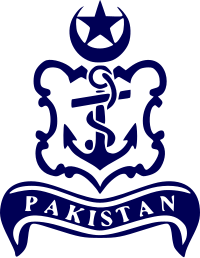 The Pakistan Navy (PN) or “Pākistān Bahrí’a” was created as the naval warfare branch of the Pakistan Armed Forces, under a 4 stars admiral acting as Chief of the Naval Staff and tasked of coastline surveillance between the Arabian Sea and Gulf of Oman. It was established in August 1947 after the country’s independence. The Navy grew from purchass and acquisitions before and in between the wars of 1965 and 1971, and more recently, after a serie of reforms and reorganizations plus the acquisition of new ships, Pakistan conducted humanitarian rescue operations at home and participated in multinational task forces under the UN banner as well as seaborne counter-terrorism.
The Pakistan Navy (PN) or “Pākistān Bahrí’a” was created as the naval warfare branch of the Pakistan Armed Forces, under a 4 stars admiral acting as Chief of the Naval Staff and tasked of coastline surveillance between the Arabian Sea and Gulf of Oman. It was established in August 1947 after the country’s independence. The Navy grew from purchass and acquisitions before and in between the wars of 1965 and 1971, and more recently, after a serie of reforms and reorganizations plus the acquisition of new ships, Pakistan conducted humanitarian rescue operations at home and participated in multinational task forces under the UN banner as well as seaborne counter-terrorism.
Since its inception it has been a volunteer force, pitted against India twice and repeatedly deployed in the Indian Ocean as military advisor to Gulf Arab states in other conflicts under the UN. This is blue water navy, albeit modest, especially compared to the Indian Navy, for exampke lacking missile destroyers and aircraft carrier, but having submarines, a Naval Aviation and Marines, as well as a Maritime Security Agency acting as coast guard and special forces. Quite small by 14 August 1947 from a purely defensive role it is now far better provided, notably having a second strike capability with underwater missiles.
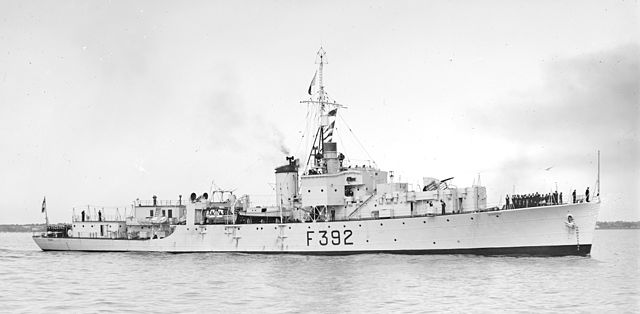
PNS Shamsher, a former River class frigate obtained in 1947 after the partition. The Pakistan CiC desperately tried for years to purchase missiles in the USSR and refit them with these, alongside two Bitter class frigates, all WW2 vintage.
For the first twenty-four years of its existence the Pakistan Navy faced the impossible task of maintaining maritime links between the two halves of history’s most geographically absurd state, round 3500 miles of hostile coastline. It inherited only two of the old RIN training establishments in August 1947. If that was not bad enough, the service came definitely last in the new Muslim state’s defence prioritics. In the air and on the ground Pakistan might hope to offset India’s permanent numerical advantage; never at sea. The Royal Pakistan Navy’s warships, like India’s, were Royal Navy transfers unul the early 1960s. A smaller cruiser acquired in 1956 was joined by a pair of ‘Battle’ class destroyers, more powerful and newer than India’s units, but on the other hand Pakistan could not match her neighbour’s seaborne air power. She did acquire the subcontinent’s frst submarine in 1964, an ex-US Tench class.
There was no maritime dimension to the 1965 Indo-Pakistan War though, according to the then Pakistan Air Force C-in-C, Indonesia offered to launch diversionary naval attacks. The service grew steadily in manpower from 7700 in 1963 to 9870 in 1970. But this build-up, including four submarines, could not match India’s and in the hectic days of December 1971 the navy’s strategic and numerical inferionty was glaringly revealed. In East Pakistan Rear-Admiral Shanti’s tour large patrol craft and seventeen MG-armed civilian boats were heutralised by Indian carrier and land-based aircraft on the first day. Thereafter the sailors became soldiers in a lost cause. Off Karachi on the same day India’s Western Fleet sank the destrover Khatbur and a minesweeper in the largest surface action since 1945 before shelling and rocketing the naval base. This treatment was repeated on 9 December with three foreign merchant ships being hit as well.
Pakistan’s only naval consolation was the submarine Hangor’s sinking of the Indian frigate Khukn in the Arabian Sea.
In defeat the navy turned to China for fast attack and patrol craft, receiving sixteen in 1972 73. By the end of 1980 the submarine force had been doubled and modernised US destroyers were being acquired. Volunteer manpower reached 22,000 in 1995 year with 5000 reserves. A naval ait arm of three Breguet Aulantic patrol aircraft and ten helicopters (both armed with AM-39 Exocet) was set up in 1975.
History
The 1947 partition
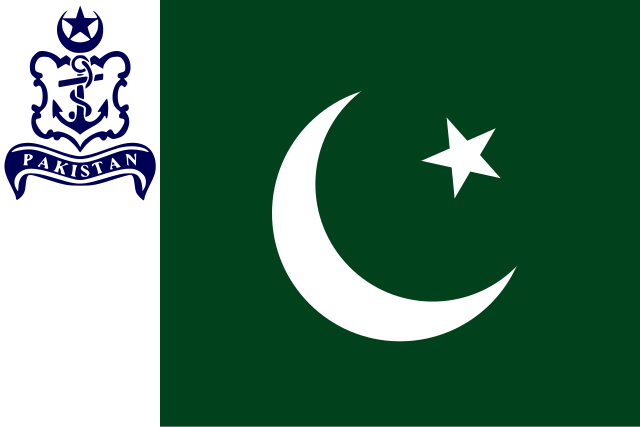
Before the Pakistani Navy there was the “Royal Indian Navy” as part of the british Empire. It ran with both Muslim and Hindu sailors. Following Gandhi’s campaign for indepdendence, then postwar negociations, there was a division of the country which emerged with a Pakistan divided itself on both sies of the Indian continent, and a separation of armed forces, notably of the Royal Indian Navy in 1947.
Muhammad Ali Jinnah addressed men and officers of HMIS Godavari in March 1948 about the creation of the Pakistani Navy on 14 August 1947:
Today is a historic day for Pakistan, doubly so for those of us in the Navy. The Dominion of Pakistan has come into being and with it a new Navy – the Royal Pakistan Navy – has been born. I am proud to have been appointed to command it and serve with you at this time. In the coming months, it will be my duty and yours to build up our Navy into a happy and efficient force.
The Armed Forces Reconstitution Committee (AFRC) under Field Marshal Sir Claude Auchinleck, last CiC India divided shares and assets of the RIN between India and Pakistan following a ratio of 2:1. Thay way, the core of the Pakistani fleet was two sloops, two frigates, four minesweepers, two naval trawlers, four harbour launches.
In 1945–46 The AFRC allocated about 2/3 of the RIN to India a third to the Dominion of Pakistan, despite larger delta areas and coast to defende between the west Arabian sea and east Bay of Bengal. India late blocked all transfer of machinery at the Bombay Dockyard to Pakistan. So the navy started in a quite challenging position.
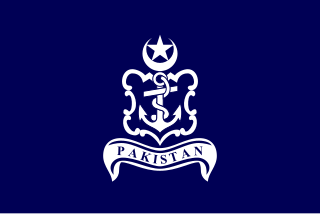
In addition to the 14 vessels, not nearly enough, there were 200 officers and 3,000 sailors, with its most senior being the Captain HMS Choudri which was chosen for his experience in staffing. 20 officers came from the Executive Branch of the Royal Indian Navy, six were mechanical engineers but there was no electrical engineer or specialist to maintain the weapons systems or machinery. There was inadequate staff, no operational base, poor financial support or skilled personnel. It was also seen as the least important military branch with federal budgets priority going to the army and Air Force. The most curcial point was the complete lack of facilities for maintenance. The only large dockyard on the subcontinent being in Bombay. Nevertheless Pakistan launched a massive recruitment programme in East Pakistan then in West Pakistan where it was decided to concentrate all efforts. But whatever preparations, the Navy was not ready for the war of 1948.
The early years 1947–1964
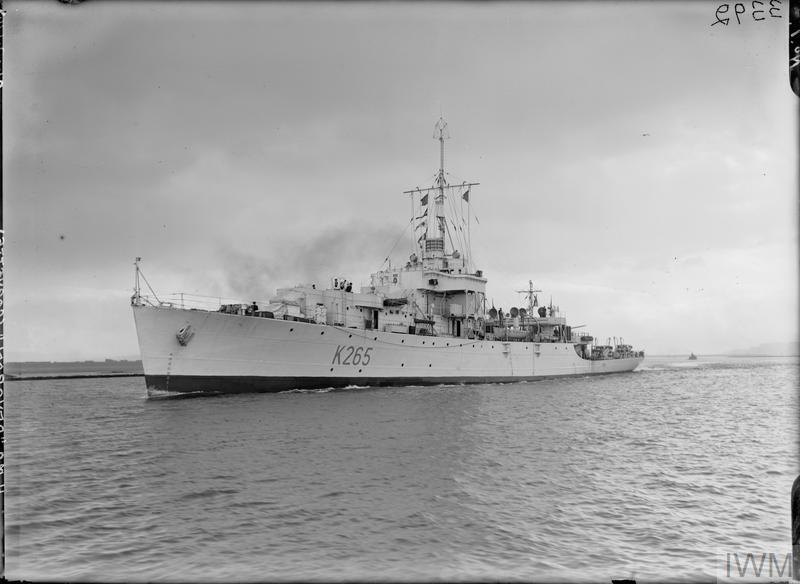
PNS Zulfiqar, former HMS Deveron, the other River class, bedrock of the fleet in the early dedade.
The Navy had an insignificant role in the first Indo-Pak war, in 1947–48. Operations happened on land and the air only. Captain Choudri commanded however a former RIN destroyer from Karachi to Bombay to evacuated Muslim emigrants to Pakistan. In 1948, the Royal Pakistan Navy moslty focus of such humanitarian missions in hostile areas, the frigates making constant rotations with an adverse Command and control, so much so PM Liaquat Ali Khan started to hire experiences WW2 vets Royal Navy officers from the British Admiralty under full agreement of Rear Admiral James Wilfred Jefford which was eventually appointed as Flag Officer Commanding (FOC). He drafted the “Short-term Emergency Plan (STEP)” to manage a proper command and control in case of an escalation of the war at sea.
In 1948, the the staff corps, DGNI was created under Lieutenant S. M. Ahsan, first first Director-General headquartered in Karachi. By the end of 1948, the Navy had its first dedicated NHQ in Karachi, followed, via British contacts, to the acquisitions of potent ships, three ex-O-class destroyers now in surplus with donation arrangements made for a transfer by the Royal Navy. They arrived too late for the war, but were quite an upgrade in capabilities anyway. The first two were acquired in 1949 (September and November) and the third in March 1951. Prior to that in 19478 were transferred four frigates, two modified Bittern and two River class frigates which played their part in the wartime evacuations.
Articles list
- Cruiser Babur (1956-85)
- Tariq class DDs (1949)
- Taimur class DDs (1954)
- Badr class DDs (1956)
- Alamgir FRAM I DDs (1977)
- Babur missile DD (1982)
- Jhelum class FFs (1848)
- Zulfiqar class FFs (1948)
- Leander class FFs (1988)
- Saif(Garcia) class FFs (1989)
- Badr(Booke) class FFs (1989)
- Tariq(amazon) class FFs (1993)
- Ghazi(i) sub (1964)
- Hangor class subs (1970)
- Hashmat clas subs (1979)
- Agosta90B class (2001)
- SX404 midgets subs
- Town class LPC (1965)
- Pakistani FACs
- Pakistani Minesweepers
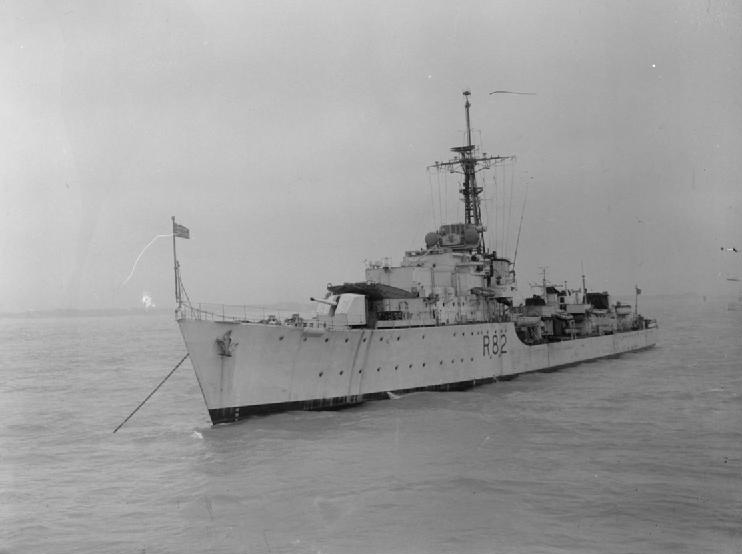
HMS Creole, later PNS Alamgir, one of the four Ch-Cr class destroyers acquired in 1954.
In 1954 were acquired one Ch-Cr class destroyer, two more in 1956, one in 1958 as well two Battle-class destroyers in 1956 also, PNS Tippu Sultan and PNS Tariq. The Battle class were cold war destroyers equipped with the latest electronics and formed the 25th Destroyer Squadron. But 1956 saw also the acquisition of a proper flagship, first and last Pakistani cruiser: C84 Babur, the ex-Bellona class light cruiser (Dido type) HMS Diadem.
In 1950 already many officers from the air force and army volunteered to join the navy and a better support led to the establishment of logistics and maintenance notably in East Pakistan.
In 1951, the government asked for a replacement of RN officers for native ones, and by 1953 the first native Pakistani Navy CiC was appointed but the British Admiralty maintained command through Rear-Admiral Jefford and his native deputy chiefs of staff, the commodore Choudhri, Khalid Jamil, Commander M.A. Alavi. To establish its existence to the world, thanks to the acquisition of a cruiser and destroyers, the Navy started also goodwill missions under the auspices of the Royal Navy.
In 1953 HMS Choudhri became the first Pakistani vice admiral with support from army CiC General Ayub Khan. The 25th Destroyer squadron was commanded by a Polish naval officer, Commander Romuald Nalecz-Tyminski.
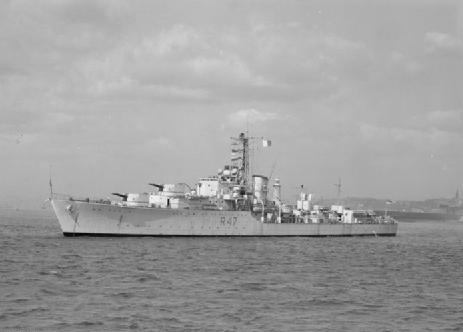
HMS Gabbard, later PNS Badr(i), one of the two Battle class destroyers acquired in 1956 and updated. They were the best assets of the fleet until the war of 1965 and submarine Ghazi.
In the mid-1950s, contracts were awarded to the Corps of Engineers in order to establish the Karachi Naval Dockyard. Alonsgide British ships aqcuisitions between 1953 and 1956, HMS Choudri negotiated with the United States to provide monetary support, hoping to modernize the old O–class/ch-Cr class destroyers and WW2 minesweepers. This ultimately succeeded when the USN sent advisers from 1955. This was the beginning of the end for British influence over the Pakistani Navy.
After promulgation of the Constitution of Pakistan the Pakistan Navy was formally established (“PN”) with a new Jack and White Ensign in 1956.
The British ships transfers announced in February 1956, were no longer donations, but purchased with funds MDAP (U.S. Military Assistance Program).
In 1958, negociations with Sweden to sell Neptun-class submarines under MDAP failed however, halted by the US. In 1958–59 however, still scarce funds started a bitter interservice rivalry. Admiral Choudri eventually resignated to the Presidency in 1959.
The Navy also started to enquire about the acquisition of an ex-British light aircraft carrier also under MDAP (partial), but when denied by the US, it was was deferred due to internal financial constraints. Instead it was decided to create a better deterrence via a potent submarine command. From 1956 to 1963, two destroyers and eight coastal minesweepers plus oiler were procured from the United States/UK in exchange of an alignment into the anti-Communist defence pacts SEATO and CENTO. That was a turning point, as India chosed at the contrary a non-aligment and rapprochement with USSR when it came to procurement.
The war of 1965
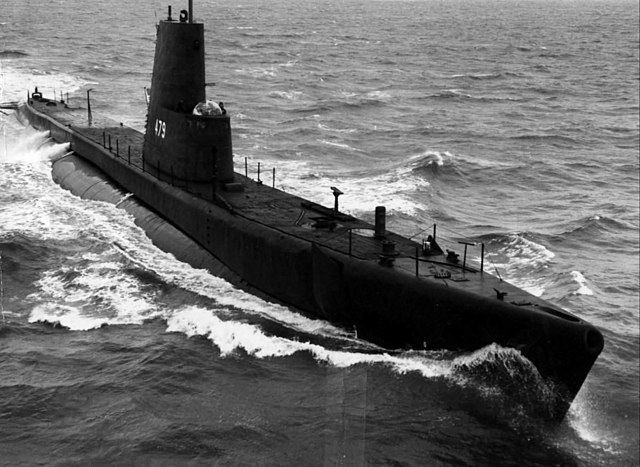
PNS Ghazi was an ex-US (USS Diablo) GUPPY Ia submarine which was probably the best asset of the Navy when commissioned in 1964. She played quite a role in that war.
After the resignation of Vice-Admiral HMS Choudri in 1959, Vice-Admiral Afzal Rahman Khan became the new CiC and worked out the procurement plan for submarine. Eventually the Royal Navy accepted to make regular visits to Karachi Naval Dockyard in order to provide a ground for submarine operations in 1960–61. The government also seeked American contributionsand eventually the U.S. Navy provided and eventually a first submarine, the ex-Tench class Ghazi under the Security Assistance Program (SAP). MoD decision was taken as India leased a first submarine from the USSR in 1963. UK also provided training eventually.
PNS Ghazi was committed in operations by 1965. In 1968, she made a circumnavigation of Africa and Southern Europe, refitted in Turkey. She was lost in the second war in 1971. At the time of the Kashmir (future Bangladesh) incursion in 1965, the Navy under CiC Admiral Afzal Rahman Khan ordered took up defensive positions off the coast but did not ventured in the Bay of Bengal. When Indian Air Force raids forced the Navy to take a more aggressive stance on 2 September, PNS Ghazi under K. R. Niazi was sent to garther intelligence on Indian naval moves and in particular INS Vikrant.
On the night of 7/8 September, the Pakistani Navy committed a full squadron of four destroyers, one frigate, one cruiser, and its single submarinea all under command of Commodore S. M. Anwar for a shore bombardment on radar facilities of the IAF, and on Dwarka.
Ghazi then was deployed in front of the Western Naval Command at Bombay and went back to Karachi on 23 September. Russia was approached to provide missile systems, to be fitted on the former British frigates but it was objected due to India’s objections. Postwar the US imposed however an embargo on Pakistan so the country began to divert its procurement notably from China, France, and the Soviet Union. The UK offered a joint development of the new Type 21 frigate but the Ayub administration maintained its cape on submarine procurement.
1966-69 reorganization
In 1966, the special operations force was created alongside the the Navy Special Service Group from UDS recommendations. In 1966–70, Pakistan kept negociating with the Soviet Navy for procurement and the latter only accepted to deliver some Osa-class FACs, but without the Styx missiles which were to arm frigates. However sticking with their strategic interests with India, it was never done. Pakistan will never acquire any vessel or weapons system from USSR.
Negociations with European submarine manufacturers succeeded, not with UK or Germany, but France: In 1968, the Daphné-class submarines were procured while Ghazi was refitted and upgraded by the Turkish Navy. Delivery became a problem with the Egyptian blockade of the Suez Canal when Ghazi had to sail there and return. At the time only the Gölcük Naval Shipyard had a facility to manage refit the Tench class outside the US.
In 1970, relations with East Pakistan deteriorated, and the Navy knew it was impossible to defend East Pakistan from the Indian Navy. The governmùent thus recruit a local naval militia called the Eastern Naval Command but this proved to be a disaster as most Bengali naval officers and around 3,000 sailors defected to India, joining instead the Awami League, Mukti Bahini.
The war of 1971
By 1971, the Navy HQ were faced with a poor presence of the Pakistani Navy on Bengal’s shores and absence of infrastructure for useful operations of the Eastern Naval Command. The Indian Navy had virtually free range in the Bay of Bengal. Only local riverine-based operations were planned, and forthis, the Navy Special Service Group (codename Barisal) arrived in April 1971. The Governor of East Pakistan was a navy officer, Vice-Admiral S.M. Ahsan. He made efforts to increase local naval presence already from 1969, while facing overwhelming opposition by the Indian Navy.
Later massive defections from Bengali officers and sailors jeopardised all operational hope. The few naval facilities were severely damaged on 15 March 1971 under Operation Jackpot. Meanwhile in Karachi it decided to at least deploy the newly modernized MLU Ghazi in the Bay of Bengal to collect intel and lead operations. Hangor of the new Daphne class was deployed in the West also for intelligence gathering purposes of the Indian Navy’s moves on the Indian shores.
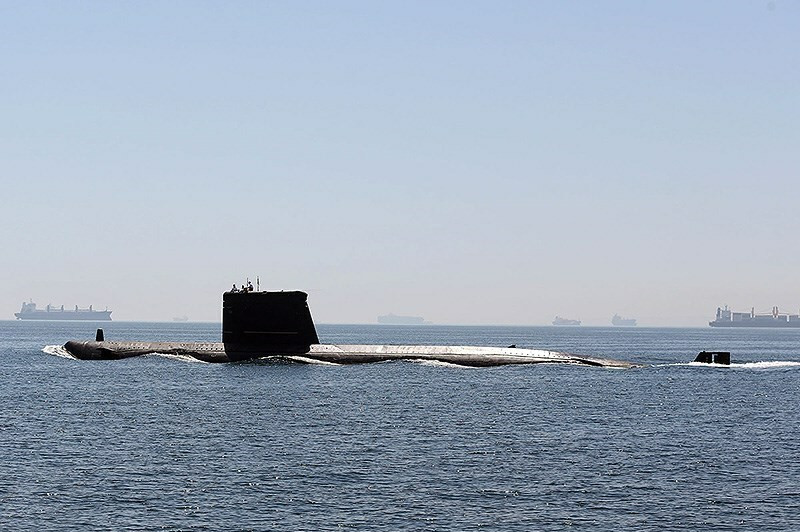
Agosta 90 submarines. They succeeded to the Agosta 80 (Hashmat) class submarines and to the previous Hangor class modelled after the French Daphne, and launched in 1969-70 but not delivered in time to take part in the war due to neutrality laws. They would certainly have broken the Indian blockade.
However this was not successful, as told by Admiral Mohammad Sharif to U.S. Admiral Zumwalt later in 1971.
PNS Nazim, the ex-intel ship USS Wiltsie would become later the “on-sea” Pakistani headquarters.
At that stage there was no naval aviation branch aither leaving Karachi vulnerable to Indian Navy attacks. The latter made a missile attack with three Soviet-built Osa-class missile boats, escorted by two ASW patrol vessels on 4 December 1971. The Styx missiles hit PNS Muhafiz and PNS Khaibar, both sunk, PNS Shahjahan damaged beyond repair.
On 8 December 1971, Hangor, under Commander Ahmed Tasnim, sank the Indian frigate INS Khukri off the coast of Gujarat (the first of such sinkings since WW2) and at least redeemed the Pakistani Navy. Later she would also torpedo and badly damage INS Kirpan.
The Pakistan Air Force had to protect Karachi and made several raids to engage the Indian Navy’s FAC squadron over the Okha Harbor, forward base but without much success whereas retaliation saw a second missile attack on the Pakistan’s coast in the night of 8 December 1971 with a FAC and two frigates on Karachi sinking the Panamanian cargo ship Gulf Star, PNS Dacca and badly damaging the British merchant ship SS Harmattan. Meanwhile the Figates shelled the facilities, with some 1,700 sailors killed at the barracks.
Commercial pilots for the national Airline also volunteered for air surveillance missions. However not trained in identification, Cdre. A. W. Bhombal misidentified PNS Zulfiqar for an Indian missile boat, so she was fired at by Pakistani F-86 fighter jets. A serious friendly fire that eventually caused the loss of the ship, too badly damaged to be recoverable, plus the losses. Later the PAF was blamed to mistake a large WW2 frigate for a small OSA FAC, and the controversy went on for some years.
PNS Ghazi, more so, to add insult to injury sank en route under mysterious circumstances, later attributed to an internal explosion or mine, and indeed claimed by the Indian Navy. With most pcapability gone, the Indian Navy enforced a full blockade of East Pakistan, preventing all reinforcements by sea. This was not all as both the Indian Navy and Air Force estroyed in all seven gunboats, one minesweeper, two destroyers, three patrol craft, eighteen cargo, and supply or communication vessels, plus untold damage to naval facilities at Karachi and around. Also were captured the merchants Anwar Baksh, Pasni and Madhumathi plus ten smaller vessels, 1,900 personnel lost, 14,13 captured in Dhaka. One frigate was damaged by an Indian Breguet Alizé, later shot down by the PAF. It amounted to 50% of the naval strenght. Many Pakistani scholars later reported the apparent lack of understanding of the Navy as a fully fledged service andwhat in can do in a combined arms strategy. What is certain is that despite its initial inferority in numbers, the poor performances could only be attributed in part to a deficient command, especially no clear direction from the government, and not the men and officers which acted diligently on call and raised to the occasion.
Modernization of the Navy (1972-90)
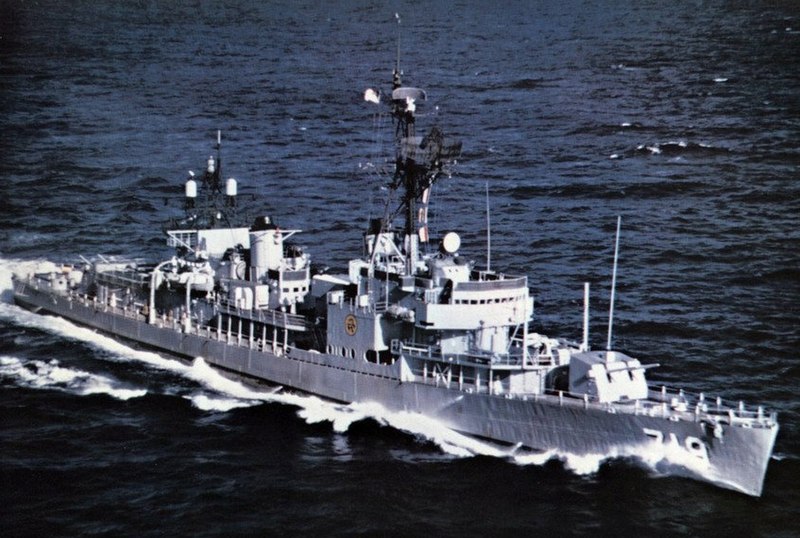
USS Epperson, later PNS Taimur, FRAM I. She was acquired in 1977 as Tariq, and other pairs followed in 1980, 82 and 1983. They were active for about ten years.
After the 1971 war it was clear the Navy needed to be modernised radically and beefed up, now that after the partition of Bangladesh, its mission was solely to defend Paksitan’s shores to the west, on the Arabian sea. It was sought to increase its operational readiness and set of achievable missions. Efforts were made to quicker promotions to naval officers and a more attractive military service by 1972–74. In January 1972 under the Bhutto administration a Commission was stup to investigate POWs held in Indian Eastern custody. A request was submitted to the Supreme Court of Pakistan to also investigate the broad causes of the failured of all thre branches. While in the US 1972, President Bhutto dishonorably discharged the commission of five senior admirals. By 1973, the Navy HQ was moved to Islamabad in order to work closer with the Army HQ in Rawalpindi.
(Next update)
The pakistani Navy today & cooperation
(Next update)
Organization
The Pakistani naval command structure
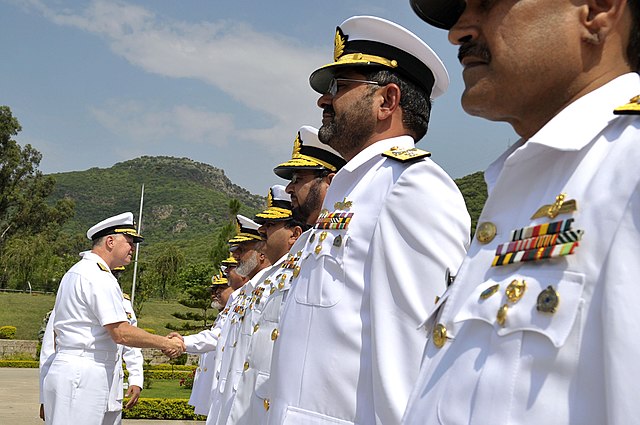
The American Chief of Naval Operations, Adm. Gary Roughead, inspecting Pakistan Navy sailors at the Navy NHQ in Islamabad in 2009
At the head is the Chief of the Naval Staff which is a four-star admiral and member of the Joint Chiefs of Staff Committee, nominated by the Prime Minister, appointed by the President. Ths post is subordonated to the Minister of Defense, controlling the department of navy from the Naval Secretariat at the MoD center in Karachi, managing all bureaucratic aspects. The Constitution points out the President of Pakistan as civilian CiC of the Armed Forces and large, and the PM is Chief Executive.
The Chief of Naval Staff is an appointed four-star rank admiral, principal military adviser on maritime security affairs to the Federal government and senior member of the Joint Chiefs of Staff Committee briefing the Prime Minister and its executive cabinet.
The Navy NHQ is located in Islamabad close to the Joint Staff Headquarters and Army GHQ in Rawalpindi, Punjab. The CNS controls and commands the Navy at all levels assisted by his Principal Staff Officers (PSOs) commissioned at the three-star, two-star rank admirals. Pakistan Navy unique command structure reflect both British and US practices.
There are seven military staff commands in the navy, all administrative under the Deputy Chief of the Naval Staff and Assistant Chief of the Naval Staff ranked as commodore, one-star rank senior officer reporting to the DCNS. Deputy Chiefs Of Naval Staff are 2/3 star ranked.
Organization
- Director General, Naval Research and Development Institute
- Director General, Command, Control, Communication, Computers and Intelligence
- Naval Secretariat, Naval Secretary
- Director General, Naval Intelligence
- Director General, Public Relations
- Naval Operations, Surface warfare
- Underwater warfare
- Electronic Warfare
- Communication
- Navigation
- Naval Supply
- Logistics
- Mechanical Engineering
- Judge Advocate General Corps
- Weapons Engineering Branch
- Naval Aviation
- Medical
- Naval Police
- Naval Intelligence
- Marines Corps
- Navy SEALs
- Maritime Security Agency
- Special Branch: Chaplain (Khatib) Service
Since restructuring and reorganisation there are today eight operational and tactical field commands, with the surface, aviation and submarines commands reporting directly to the senior Pakistan Fleet Command, each under a senior flag officer (2/1 star rank, Vice-Admiral or Rear-Admiral).
There is the Commander Karachi (COMKAR), Commander Central Punjab (COMCEP), and Commander Northern (COMNOR), responsibe of local naval installations and offshore establishments, as well as training facilities, see ‘bases” below.
In 2012, the Naval Strategic Forces Command was created to manage the sea-borne nuclear second strike capability.
Peacetime commands comprises the Headquarters at Islamabad in Pakistan, Operational, Tactical Commands with Subordinate combat squadrons responsible for operational deployments Surface, Sub, Aviation and ensuring their operational readiness.
The Commander, Karachi (COMKAR) and subordonated offshore establishments, training schools, and coastal defence, Karachi coast.
The Commander, Coast (COMCOAST) Directs the coastal command from the Iranian border to Indian borders.
The Commander, Naval Strategic Forces Command is responsible for the nuclear second strike capability
The Commander, Logistics (COMLOG) oversee maintenance, logistics, material readiness in shipyard.
The Sea Training (FOST) oversees training deployment.
The Commander, Central Punjab (COMCEP) Oversees deployments of the War College in Punjab
The Commander, West (COMWEST) directs operation on Western Pakistan, with Commander, North for Northern Pakistan
The Commander, Depot (COMDEP) is oversee all the naval supplies and materials stored and distributed, works with COMLOG.
The Commander, Naval Aviation is reporting to COMPAK
The Commander, Submarines (COMSUBS) reports to COMPAK
The Director of Procurement, Navy purchases equipments and supplies for the navy, reports to DCNS.
Special operations forces
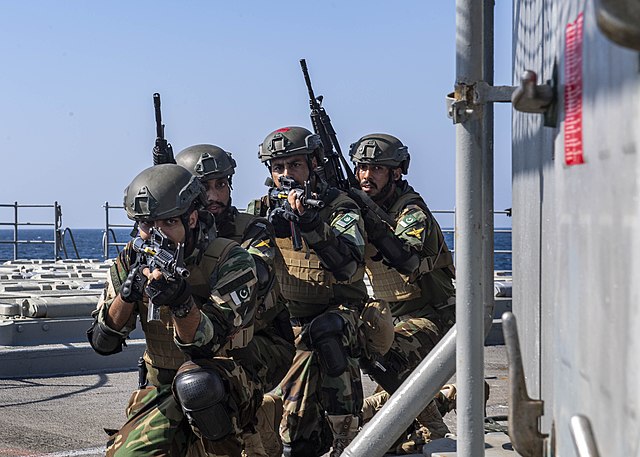
The Special Service Group (Navy), SSG(N) or SSGN is an elite unit for unconventional warfare, diving, interdiction and asymmetric operations, shaped after the Navy SEALs from 1966. It saw action in the war of 1971. This branch is headquartered at PNS Iqbal, Karachi where weapon tactics training is done. Its modenr tasks as boarding suspect ships (board, search, seizure, scuttling or interdiction) as well as security operations and prevention of seaborne terrorism.
The number of personnel remains classified as its deployment.
In 1970–71, the Pakistan Marines were created to manage amphibious warfare operations, heavily influenced by the USMC, until decommissioned in 1974. On 14 April 1990 it was recommissioned and reached 2,000 personnel. Advanced training is done at the School of Infantry and Tactics in Quetta, Balochistan.
The 1st Marines Battalion is also specifically trained for infiltration and AA warfare operations, deployed in Sir Creek.
Combat Doctrine
The Current Pakistan Naval doctrine had been shaped to avoid the 1971 Indian blockade of its coasts and until 1971, the Pakistan Navy lacked clear direction, being a glorified coast guard without strategy to protect sea lines of communication. In 1971 the blockade of Chittagong and Karachi completely nullified any possibility of action. Not breaking the blockade led to economic hardship and cutting communication with east Pakistan. Postwar, the federal government massively increased funding and focused on the development of more aggressive deployments and long-range, in depth operations off the Indian coast. Submarines were tasked to to target and destroy Indian surface assets and then staand guard off Indian ports. Karachi harbour was mined, and this led to take mine warfare seriously. There was a setup to prevent also at sea incoming missile attacks. In 1983–85, Dassault Mirage 5 were purchased from France modified to carry the Exocet missile and create a mobile 500 kilometres (310 mi) threat area in the Indian Ocean.
Routine deployments are done with the Combined Task Forces and since 1999, Pakistan Marines’s special reconnaissance forces deployed from Sir Creek are better formed for offshore protection against Indian paradropped spec ops incursions from the sea and its own deployment behind enemy lines with HALO/HAHO airdrop or usung Italian built midget submarines.
With the development of the INS Arihant, the Pakistan Navy launched is own nuclear powered submarine program with Chinese help by 2012. In 2017 the ISPR announced the acquisition of its first sea-based second strike capability with the nuclear SLCM based on the Babur cruise missile, albeit short range. There are no plan for a SSBN (known) actually but certaionly of AIP nex generation miss-carrying subs, tube-launched, with that short range nuclear strike capability.
The Pakistani fleet in detail
Surface Fleet
Ships are prefixed “PNS” for Pakistan Navy Ship. Naming conventions are selected by the Ministry of Defense, honouring important people or places, then commissioned by the President. Today the fleet comprises circa 100 vessels including those of the Maritime Security Agency and Pakistan Marines, down to their inflatables ribs. The Navy diversified uch its procurement given ucertain politics with Turkish, American, Chinese and local construction. This includes the Turkish-designed Babur class corvettes, locally-built Zulfiquar-class frigate with Chinese assistance. Decommissioning of Tariq class destroyers (Gearing) was compensated by additional Zulfiquar-class frigates by 2021 and acquisition of the Type 054A frigates from China from 2017. The Tariq class guided missile destroyers served with the 25th Destroyer Squadron. The F-22P Zulfiquar class guided missile frigates serves with the 18th Destroyer Squadron completed by the OH perry class PNS Alamgir since 2011. In 1992, the French Navy transferred its Tripartite-class minehunter and took part in the design of local Munsif-class minehunters.
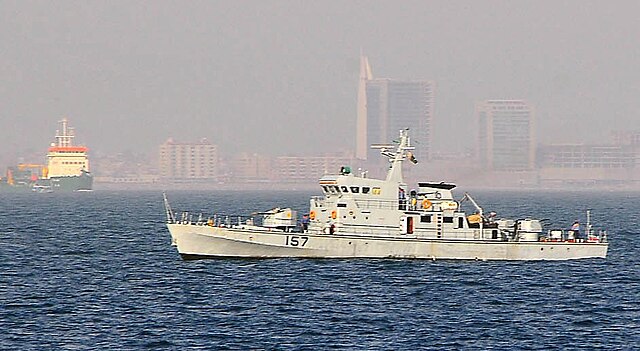
In 2011, the Navy commissioned its Azmat-class corvette (Chinese Type 037II) Houjian FAC/M. with the 10th Patrol Squadron, reinforced by two Jurrat-class missile boats (German-designe) and Turkish design MRTP. The Larkana-class gunboats were produce at KSEW Ltd, Karachi as the Fast Patrol Craft Squadron.
There is a force of coast guard ships used by the Maritime Security Agency mostly imported from China or locally build. They guard seaborne borders.
In 2017, the Pakistan Navy negociated with the Turkish Navy to acquire four MILGEM-class ships and for a technology transfer on 5 July 2018. The Pakistan Navy Fleet Tanker Project (PNFT) also was a joint project with Turkey as prime contractor from 2018.
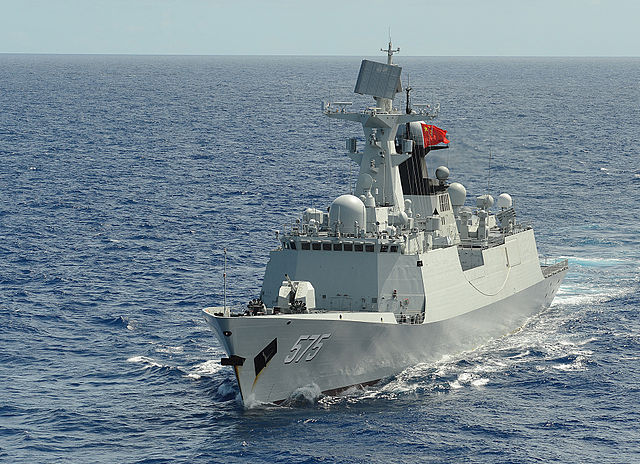
Chinese Type 054A frigates
On 1 June 2018, Pakistan Navy ordered four Type 054As frigates, commissioned 2021. In 2021 outgoing Chief of Naval Staff (CNS) Admiral Zafar Mahmood Abbasi profesed to add 50 more vessels, including 20 major surface combatants, including four modified Ada class corvettes from Turkey and two multi-purpose Yarmook class corvettes from Damen Shipyards and twenty fast attack missile boats which remains to be sourced.
Submarines
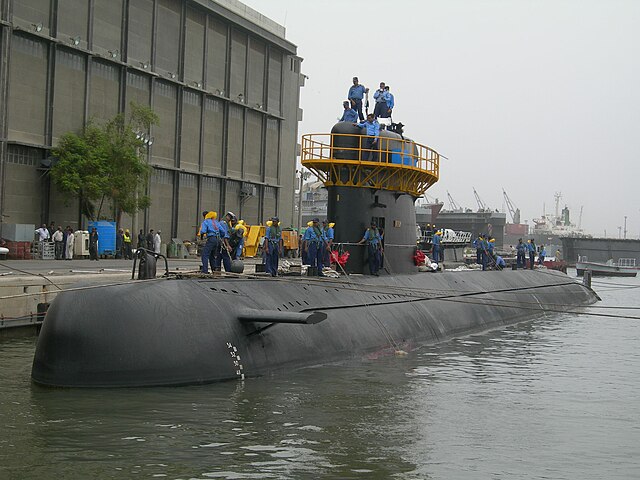
PNS Hamza, an air-independent-powered Agosta 90B-class submarine, being prepared to go through the depth tests in 2007
Established in 1964, the Submarine Command is tasked to conduct clandestine military reconnaissance, intelligence gaterhing and precision strikes in wartime.
Eight submarines are in active service, with the Hashmat-class (Agosta-70A) three Italian–designed, locall midget Cosmos-class (X-Craft 140) submarines.
The Agosta had an air-independent propulsion (AIP) for longer range and deeper dives, armed with tube-launched Exocet and Babur-III missiles. Two have undergone refitting and modernisation by STM in Turkey.

Yuan class diesel electric submarine
In 2014, Pakistan negociated with China to procure four Yuan-class AIP powered submarines, and a technology transfer signed in April 2015. This is the Hangor-class, with AIP, in joint-venture for a commissionion between 2023 and 2028.
After INS Arihant was made public, the Pakistan Navy obbtain an agreement fore the procurement of a nuclear-powered submarine scheduled for a commission in 2028, likely negociated with China.
In April 2014, submarine operations were moved to the new Jinnah Naval Base in Ormara with training at PNS Abdoze, Karachi. By May 2008 was established also on USN advice the Fleet Acoustic Research and Classification Centre to have good safety standards and underwater tracking.
Pakistani Auxiliary Ships
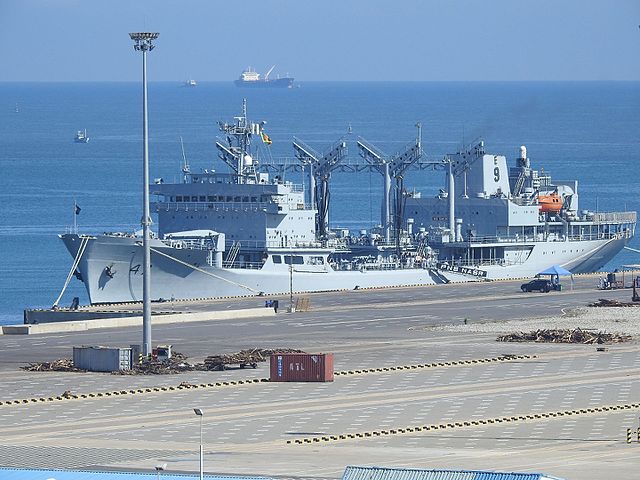
Pakistani Naval Aviation
Bases
Naval Academy and schools
Full list
 Cruiser Babur (1956)
Cruiser Babur (1956)
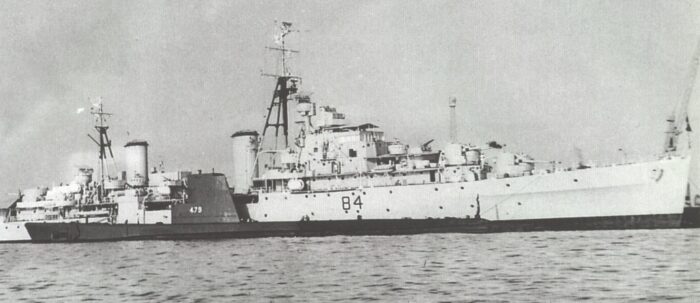
The Ex-British BELLONA class cruiser had been originally launched at Hawthom Leslie on 29.2.56 as HMS Diadem. Before beibng sold to Pakistan and renamed C84 BABUR (i) she had been refitted at HM Dockyard in Portsmouth. Her bridge was modified as well as her radar upgraded and lattice masts reinforced. Babur was the Mogul emperor. She was recommissioned on 5 July 1957 and adapted as a training ship after her 1961 refit, then reduced to harbour service until replaced in 1982 by the new Babur, renamed Jahangir. The C prefix dropped from pennant number in 1963. She was BU in 1985.
 Tariq (O class) Destroyers (1949)
Tariq (O class) Destroyers (1949)
Ex-British ‘O’ class destroyers.
Class:
-D21 TARIQ (i) Fairfield 30.11.49 BU 1959 (ex-Offa)
-260 TIPPU SULTAN (i) John Brown 30.9.49 Stricken 1980 (ex-Onslow)
-261 TUGHRIL (i) Fairfield 3.3.51 Stricken 1977 (ex-Onslaught).
Refit and conversion of Tippu Sultan and Tughril to Type 16 frigates with US MDAP funds agreed in London on 29 April 1957. Both ships were converted at Liverpool but Tariq was handed back to RN in 1959. Tughril was disarmed in 1977 and used as midshipmen’s naval academy training ship. Tippu Sultan was stripped 1980 with her hulk being used as a work platform.
 Taimur (Cr-Ch class) destroyers (1954)
Taimur (Cr-Ch class) destroyers (1954)

Ex-British ‘Ch’ and ‘Cr’ class destroyers.
Class:
-TAIMUR (i) (ex-Chivalrous) Denny 29.6.54, BU 1961
-D 160 ALAMGIR White 29.2.56 BU 1982 (ex-Creole)
-D 162 JAHANGIR White 29.2.56 BU 1982 (ex-Cnispin, ex-Craccher)
-D 164 SHAH JAHAN Thornycroft 16.12.58 BU 1982 (ex-Chanty).
Taimur was lent by RN after 22 October 1953 agreement, handed over at Liverpool, and returned to UK in 1960. Alamgir and Jahangir bought in 1956 and modernised with US MDAP funds by Thornycroft being handed over to the Pakistan Navy on 18 March and 20 June 1958 respectively at Southampton. Shah Jahan bought by US under MDAP and handed over at Cowes after refit by White.
 Badr class (Battle) destroyers (1956)
Badr class (Battle) destroyers (1956)
Ex-British ‘BATTLE’ class destroyers.
Class:
-D 161 BADR (i) launched Swan Hunter 29.2.56, BU 1989 (ex-Gabbard)
-D 163 KHAIBAR (i) Fairfield 29.2.56 Sunk 5.12.71 (ex-Cadiz).
Modernised and refitted with US MDAP funds, Badr at Yarrow being handed over on 24 January 1957 and sailing for Karachi from Portsmouth on 17 February 1957 Khazbar refitted by Gowan, Glasgow, and handed over 1 February 1957, Both named aftewr early Islamic victories. Kharbar sunk off Karachi by Indian ‘Osa’ FAC 5 December 1971. Badr became HQ ship of the new Maritime Safety Agency in 1985.
 Alamgir (Gearing FRAM I) class destroyers ()
Alamgir (Gearing FRAM I) class destroyers ()
These Ex-US GEARING (FRAM J) class destroyers became the greatest asset of the Pakistani Navy when they arivced in the 1980s. Plus they were compatible with Turkish upgraded ones for overhauls.
Class:
-D 160 ALAMGIR (Built at Bethichem, transferred 1.10.82 as ex-Cone, decommissioned 4 December 1998
-D 164 SHAH JAHAN (ii) (Bethichem, 1.10.83, ex-Harold J. Ellison), discarded 1995.
-D 165 TARIQ (ii) (Federal, 29.4.77 ex-Wltyte) MSA 1990
-D 166 TAIMUR (ii) (Federal, 29.4.77 ex-Epperson) Disposed of 1994
-D 167 TUGHRIL (ii) (Todd-Pacific, 30.9.80, ex-Henderson) Disposed of 1994
-D 168 TIPPU SULTAN (ii) (Bethlehem, 30.9.80 ex-Damato. Disposed of 1994
The First pair was refitted by Campbell Industries in San Diego for $7.43m in 1977-78. Tariq was completed by 2 June 1978, Taimur 16 February 1978. Tariq replaced Badr as flagship of Maritime Safety Agency 25 January 1990 and renamed Nazim (D 150). Now alare disposed off since the late 1990s.
 Babur(ii) Missile Destroyer (1982)
Babur(ii) Missile Destroyer (1982)

Ex-British ‘COUNTY’ class guided missile destroyer. She became C84 BABUR (ii) originally from Swan Hunter, transferred in Feb 1982 as ex-London, bought in February 1982 and refitted, with Seaslug SAM system removed at the stern. She was handed over 24 March 1982 and her flight deck extended adn reinforced to fly Sea King Mk.45 and she had Mk 15 Phalanx CIWS added on the former hangar plus three twin 37mm/45 gun mountings added. She carried usually the Alouette III helicopter, and operated the type 170B and type 174 sonars, replaced by a type 176 sonar. She became a training hulk in 1993. So short service here again.
 Jhelum (Bittern) class Frigates (1948)
Jhelum (Bittern) class Frigates (1948)
These were ex-British modified BITTERN class frigates. Class: F40 JHELUM Thornycroft 1948 BU 1959 (ex-Narbada), F32 SIND (Thornycroft transferred 1948) for disposal c1960. Transferred by India in 1948. Sind was refitted by its original builders at Southampton 1949-50 and toured Australasian ports 1951. Jhelum was refitted 1950-51, retaining her tripod mast until also replaced by lattice in Karachi 1955. Also fitted as flagship.
 Zulfiqar (River) class frigates (1948)
Zulfiqar (River) class frigates (1948)
These were Ex-British ‘RIVER’ class frigates.
Class:
-F265 ZULFIQUAR (Smiths Dock) transferred 1948, BU 1983 (ex-Dhanush, ex-Deveron)
-F392 SHAMSHER (Smiths Dock) transferred 1948, BU 1960 (ex-Nadder)
Both transferred by India in 1948, Shamsher became a training ship. Zulfiquar became a survey ship in 1951 with her aft 4-in removed to fit a charthouse. She surveyed for the new port of Chalna, East Pakistan. Renumbered 262 in 1963.
 Zulfiqar(Leander) class frigates (1988)
Zulfiqar(Leander) class frigates (1988)
Class: -F262 ZULFIQUAR acquired 14.10.88 (ex-Apollo), discarded 2001. F263 SHAMSHER 15.7.88 (ex-Diomede), discarded 2007.
Ex-British ‘LEANDER’ class frigates. Two broad-beamed Leanders were bought from the Royal Navy in 1988, The only change made was to add an Alouette III helicopter.
 Saif (Garcia) class frigates (1989)
Saif (Garcia) class frigates (1989)
Class: Saif, Alsat, Khaibar, Siqqat acquired in 1989; returned in november 1993, placed on disposal list, BU. So just 4 years service.
Ex-US ‘GARCIA’ class frigates No Name Acquired Fate F 264 SAIF 31.1.89 Returned Jan 1994 (ex-Garcia) F265 ASLAT 8.2.89 Returmed 14.11.93 (ex-O’Callahan) F 266 KHAIBAR (ii) 31.3.89 Retumed 14.11.93 (ex-Brumby) F267 SIQQAT 31.5.89 Returned 1993 (ex-Koeisch).
Four ASW frigates were acquired from the US Navy and arrived at Karachi in July 1989, Mk 15 Phalanx CIWS to be fited 1991 92, but towed array removed before Saif was handed over.
 Badr(Brooke) class frigates (1989)
Badr(Brooke) class frigates (1989)
Class: F161 BADR (ex-Fulius A Furer), F162 HARBAH (ex-Brooke), F163 TABUK (ex-Richard Page), F164 HUNAIN (ex-Talbot), acquired 1989, Returned in 1993, also 4 years service.
Ex-US BROOKE class missile AAW frigates acquired from the US Navy and arriving at Karachi July 1989. Badr received Mk 15 Phalanx CIWS on flight deck in 1990, others followed.
 Ghazi (1964)
Ghazi (1964)

Author’s rendition of PNS Ghazi
A single fleet snorkel ww2 Tench class submarine. Ex-US TENCH class submarine No Name Builder Acquired Fate S130 GHAZI (i) Portsmouth 1.6.64 Sunk 4.2.71 (ex-Diabolo) N Yd Loaned by USN after Fleet Snorkel conversion at Philadelphia N Yd. Commissioned Ghazi (‘Defender of the Faith’) at USN Submarine Base, New London, Connecticut. Sunk by Indian ASW surface ships off Visakhapatnam while trying to torpedo the carrier Vikrant at the start of the third Indo-Pakistan War.
 Hangor class submarines (1970)
Hangor class submarines (1970)

Class: S131 HANGOR, S 132 SHUSHU (both launched 12.1.70), S 133 MANGRO launched 8.8.70, S 134 GHAZI (ii) launched 25.1.69, ex-Cachalote.
French Daphne class from Brest, Arsenal de La Ciotat and AC Dubigeon with some internal modifications for Pakistani service. First pair laid down 1 December 1967 and in service 12 January 1970. Second laid down 8 July 1968 and in service 8 August 1970. Ghazi was bought from Portugal in December 1975. Hangor torpedoed and sank the Indian INS Khukri on 9 December 1971, first such attack since 1945. They were all stricken in 2006.
 SX 404/Cosmos class submarines (1972)
SX 404/Cosmos class submarines (1972)
Italian SX 404 type midget submarines. Displacement: 40t Dimensions: 52ft 5in oa x 6ft 7in 16.97m x 2.0m Machinery: 1-shaft electric = 11kt/6! 2kts. Range 1200nm surface, 60nm underwater Complement: 4
Commercial rather than naval design of midget submersible capable of carrying 12 passengers. Built 1972-73 by Cosmos, Livorno, and five out of six still inservice. Diving depth 330ft (100m). One lost at sea 27 December 1976. See under Taiwan. Replaced by three new midgets in 1990s, probably of SX 756 design. Three 150t midgets built with Italy, mini-submarines designed by Italian firm M/s COSMOS in 1986, built in Karachi Shipyard under Technology transfer agreement.
 Basset class armed Trawlers (1948)
Basset class armed Trawlers (1948)
Ex-British BASSET class trawlers Class: Bahawalpur (P 149, ex-Baroda, ex-Lucknow, Shalimar, for disposal c1960), Lahore (P 12, ex-Rampur, ex-Barisal, Burn, for disposal c1960). Two transferred from India 1948. Ex-Chinese ‘HUCHWAN’ class torpedo hydrofoils Class: HDF 01-04 Transferred from China 1973 and all four sold 1992. Ex-Chinese ‘HUKU’ class fast attack craft (missile) Four transferred from China 1981-82. All extant 1995.
 Rajhashi/Town class large patrol crafts (1964)
Rajhashi/Town class large patrol crafts (1964)
‘TOWN’ class large patrol craft Displacement: 115t standard; 143¢ full load Dimensions: —107ft x 20ft x 11ft 36.6m x 6.1m x 3.4m Machinery: 2 shafts, 2 MTU 12V 538 diesels, 3400bhp = 24kts Armament; 2-40mm/70 (600rds) Complement: 19 24 Class (no): Rajshahi (P 140), Jessore (P 141), Comilla (P 142), Sylhet (P 143).
Ordered from Brooke Marine on 5 October 1963 and named after East Pakistan towns. Jessore and Comilla commissioned 20 May 1965, Rajshahi and Sylbet 2 August 1965. Specially strengthened hulls with sea resistant alumin. lum alloy superstructures. All were attacked by Indian aircraft on 4 December 1971. Off Chittagong Rajshahi was hit six times by four Hunter jets, set on fire, losing one killed and six wounded but regained port after the crew checked flooding and fire in the engine room, Extant 1995. Nine aircraft sank Comilla in the same action. Jessore and Sylhet destroyed in air strikes from the carrier iran the same day at Khulna to the West. Jessore salvaged by Bangledeshj
 Lahore(Shanghai II) class Large Patrol Craft (1972)
Lahore(Shanghai II) class Large Patrol Craft (1972)

Ex-Chinese ‘SHANGHAI ID’ class large patrol craft
Class: Lahore (P 140), Quetta (P 141), Mardan (P 143), Gipit (Po 144), Profit CP 145), Sukkur (P 147), Sehevan (P 148), Raharvalpur (P LA9), Bare (P 154), Kalat (P 156), Larkana (P 159), Sadival (P 160). Eight transferred 1972, four in 1973. All named afier Pakistani cities. Pour transterred to Maritime Security Agency: only Po144, P1445 and P 149 extant 1995.
 Baluchistan(Hainan) class Large Patrol Craft (1976)
Baluchistan(Hainan) class Large Patrol Craft (1976)
Ex-Chinese ‘HAINAN’ class large patrol craft. Class: Baluchistan (P_ 155), Sind (P1159), Sarhad (P 161), Punjab (P 197). First pair transterred mid-1976, second April 1980. Baluchistan for disposal 1992, remainder stricken 1993/1994.
 Haibat(Hegu) class FACM (1981)
Haibat(Hegu) class FACM (1981)
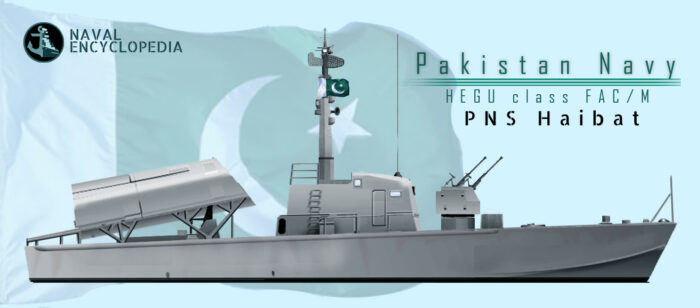
Ex-Chinese ‘HEGU/HOKU’ class fast attack craft (missile) Class (no) Harbat (P 1021), Falalat (P 1052), Furat (P 1053), Shujaat (P 1054)
First pair transferred 5 May 1981, second pair October 1981. Extant 1995
 Azmat(Huangfeng) class FACM (1984)
Azmat(Huangfeng) class FACM (1984)
Ex-Chinese ‘HUANGFEN class fast attack craft (missile)
Class: Azmat (P 1025), Dehshat (P 1026), Himmat (P 1027), Guwwat (P 1028).
Four transferred from China April 1984. All extant 1995.
 Small patrol craft
Small patrol craft
Eighteen MC 55 class (22.8t full load, 54ft lin x 17ft x 2ft 10in, 16.5m x 5.2m x 0.8m, 2 V6 diesels, 1600hp = 30kts, 1-14.5mm MG, 5 crew): P 551-568 built by Crestitalia and delivered 1979 80. GRP units, P 553 named Vagar.
One Fairey Marine ‘Spear’ class.
Four ex-British SDMLs: SDML 3518 and 2519 BU 1965. SDML 3517 and 3520 stricken 1975-77.
 Dacca(Bangor) class minesweepers (1948)
Dacca(Bangor) class minesweepers (1948)
Ex-British BANGOR class minesweepers. Class (no, former name): Dacca (M 245, ex-Oudh), Peshawar (M 55, ex-Malwa), Baluchistan (M 182, ex-Greenock), Chittagong (ex-Kathiawar, ex-Hartlepool)
Transferred from India 1948, second pair were turbine-powered. Dacca and Baluchistan for disposal c1960; Chittagong sold 1956; Peshawar sold 1959.
 Makhmood(Bluebird) class minesweepers (1957)
Makhmood(Bluebird) class minesweepers (1957)
Ex-US BLUEBIRD class coastal minesweepers Class (no, former no, transfer): ; Mahmood (M 160, MSC 267, Apr 1957), Momin (M 161, MSC 293, Jul 1962), Mubarak (M 162, MSC 262, Jan 1957), Muhafiz (M 163, AMS 138, 25.2.55), Mujahid (M 164, MSC 261, Oct 1956), Mukhtar (M 165, MSC 274, 25.6.59) Munsif (M 166, MSC 273, 25.6.59), Moshal (M167, MSC 294, 13.7.63). Momin and Moshal have lower bridges than the other six. All built under MAP. Mujahid and Mubarak arrived Karachi on 5 December 1957. Munsif stricken 1979, Muhafiz sunk off Karachi by Indian Navy on 5 June 1957. Momin, Moshal and Mubarak stricken in 1980s, Migahid in 1990; only Mahmood and Mukhtar extant 1995, and to be replaced by the new minehunters.
Modern Assets
 Tariq (Amazon) class frigates (1993)
Tariq (Amazon) class frigates (1993)
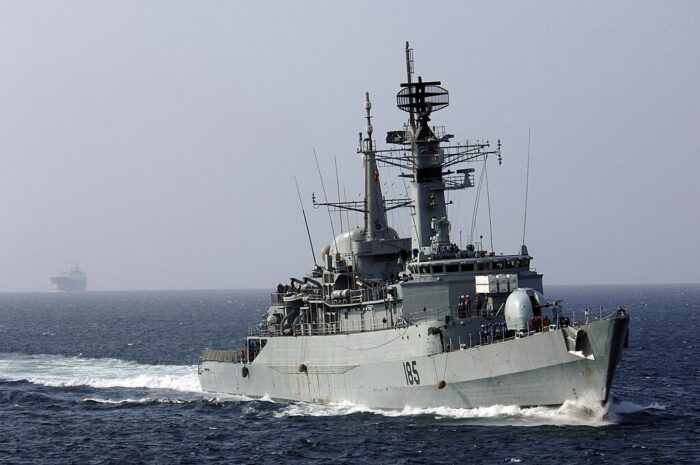
Ex-British AMAZON class frigates Armament: 4 RGM-84 Harpoon SSM, 1-4.5in/55 Mk 8, 2~30mm (1 x 2), 1~20mm Phalanx CIWS, ? Tp 45 ASW TT, 1 Lynx helicopter Sensors: Radar DA-08, RTN-10X; sonar ATAS(V)2 Other particulars: As British Amazon class No Name Acquired Fate F 181 TARIQ (iii) 28.7.93 Extant 1995 (ex-Ambuscade) F 182 BABUR (iii) 30.9.93 Extant 1995 (ex-Amazon) F 183 KHAIJBAR (iii) 1.3.94 Extant 1995 (ex-Arrow) F184 BADR (iii) 1.3.94 Extant 1995 (ex-Alacrity) F 185 SHAH JEHAN (iii) 23.9.94 Extant 1995 (ex-Active) F 186 TIPPU SULTAN (iii) 23.9.94 Extant 1995 (ex-Ambuscade) Purchase of all six Type 21 frigates from the RN was announced on 27 April 1993, but the deliveries were phased over 14 months. To be fitted with new Dutch radar and active towed array sonar (ATAS), French DR-3000S electronic warfare suite and Swedish 9LV Mk 3 combat data system.
 Tughril class frigates (2020)
Tughril class frigates (2020)
PNS Tughril (F261), Taimur, Tippu Sultan, Shah Jahan. First two ships were commissioned in 2022 while the remaining two were commissioned in 2023.[10]
 Zulfiquar class frigates ()
Zulfiquar class frigates ()
Based on updated Type 053H3 frigates.[11] Design is also influenced from Type 054. The F-22P’s hull contains type 054 frigate’s radar cross-section reduction. First three ships were constructed in China and the fourth ship was built in Pakistan by Karachi Shipyard with transfer of technology.[12][13][14]
 Jinnah class frigates
Jinnah class frigates
The Jinnah-class Frigate is currently under final stages of design phase. Model of Jinnah Class Frigate for Pakistan Navy revealed in IDEF 2021 Turkey. These ships will be made in Karachi Shipyard under Transfer of Technology (ToT) agreement from Afsat Turkey . Pakistan plans to build upto 6 Jinnah frigates after construction of all Babur class corvettes. Estimated timeline of delivery of 6 ships is between 2030s to mid 2040s. [16][17][unreliable source]
 Babur class corvettes
Babur class corvettes
PNS Babur (F280), PNS Badr(F281), PNS Khaibar(F282), PNS Tariq(F283), Based on Tukish MILGEM project.[18] PNS Badr (F281), PNS Khaibar (F282) and PNS Tariq (F283) are undergoing outfitting[19] while PNS Babur (F280) has been commissioned.[20
 Yarmook class corvettes
Yarmook class corvettes
PNS Yarmook (F271), PNS Tabuk (F272), PNS Hunain (F273), PNS Yamama (F274). 2,300 tons (batch-I) 2,600 tons (batch-II) Dutch shipbuilder Damen built PNS Yarmook commissioned in Feb 2020. PNS Tabuk commissioned on 12 November 2020.[21][22][23][24][25] Batch-II with 2 more OPVs are on order. Batch-II ships are based on Damen OPV 2600. These ships will be armed with Ashm and Anti-Air systems and will be designated as guided missile corvettes in PN. PNS Hunain (based on OPV 2600) was launched by Damen Shipyards on 14 September 2023 followed by the launch of PNS Yamama on 19 February 2024.[26][27][28] PNS Hunain (F273) was commissioned on 26 July 2024.[29
 Azmat class corvettes
Azmat class corvettes
PNS Azmat (1013), PNS Dehshat (1014), PNS Himmat (1027), PNS Haibat (1028) 560 tons ships built at Xingang Shipyard in China and the rest in Karachi under Transfer of Technology agreement.
 Agosta-90B class
Agosta-90B class
PNS Khalid, Saad, Hamza. when France cancelled an order for ??Agosta class submarines destined fof soit Arica they were quickly bought by Pakistan in November 1978, They “d been built in 1976 79, and Hashmat (completed 17 Vebruary 1979) arred at Karachi 31 October 1979. Hurmart was completed on £7 Vebruary 80; ind amved Karachi 11 August 1980. SM-39 Lxocet not fitted. french AGOSTA-90B type submarimes ; pisplacemient: 1510t 1760t pimensions: 22 x 22tt 4in x 17ft 9in 67.S7m x 6. 8mix Sdn ‘ Machinery: L-shatt diesel-clectric=12.5kts 20. 3kts yemament: 4 533mm VT (20 F17P torpedoes plus SM39 Exocet) gensorst Sonar DUUA-1D, DUUA-2A/B, DUUX-2A Complement: — 36 No Name Builder Commissioned Fate . DCN Cherbourg Projected 1999 Building . : Karachi Naval Dyd Projected 2000 Ordered – Karachi Naval Dyd – Projected An agreement worth US$ 950m was signed 20 September 1994 for four boats. Fint of class laid down early 1995, to complete 1998 99. Second unit will be put in sections at Cherbourg and assembled at Karachi. The third unit will be fired with an 8m ‘plug’ containing a 200kKW MESMA air-independent propulson system, which will be retro-fitted to the two earlier boats. To be equipped with the SUBTICS command system developed from that fitted in the new French SSBNs. They are the first export submarines to be equipped with §M39 sub-launched Exocet.
 Agosta-70 class
Agosta-70 class
PNS Hashmat (S135), PNS Hurmat (S136). HASHMAT class submarines __ No Name Builder Commissioned Fate 905 . 1 S135 HASHMAT AC Dubigeon 7.2.79 Extant 5 (ex-Astrant) 1995 136 HURMAT AC Dubigeon 6.2.80 Extant (ex-Adventurous).
 Hangor class submarines (2020)
Hangor class submarines (2020)
PNS Hangor(Shark) Ghazi (Warrior), Shushuk (dolphin), Mangro, Tasnim, Seem Maai, 2 more unnamed.
Eight Type 039A/041 submarine heavily modified for Pakistan are on order – with the first four being built in China by the China Shipbuilding Trading Company (CSOC) and the last four being built in Pakistan by the Karachi Shipyard & Engineering Works (KSEW).[7] The first four submarines are expected to be delivered by 2025, while the last four are expected to be delivered by 2028.[8]
2,800 t (2,800 long tons)[3], 76 x 8.4 x 6.2 m (249 ft 4 in x 27 ft 7 in x 20 ft 4 in)
Propulsion: 4x CSOC CHD620 diesels, Stirling-powered AIP: 20 knots
Armament: 6 x 533 mm (21 in) TTs, Babur 3 cruise missiles, YJ-82 anti-ship missiles, Yu-6 torpedo
 Munsif(Tripartite) class minehunters (1992)
Munsif(Tripartite) class minehunters (1992)
French ‘ERIDAN’ type minehunters. Class (no, former name): Munsif (166, ex-Sagittaire), Muhafiz (167), Mahmood (168)
Three Tripartite GRP minehunters ordered from DCN January 1992, one transferred in November 1992 from the French Navy, one launched by DCN Lorient on 8 July 1995 and one to be built at Karachi Naval Dockyard with DCN assistance.
Read More/Src
Books
Links
paknavy.gov.pk/
web.archive.org/ pkdefense.com/forums/pakistan-navy.11/
navypedia.org pakistan
hilal.gov.pk/
bharat-rakshak.com/ dwarka/
en.wikipedia.org list active Pakistan Navy subs
Pakistan_Navy

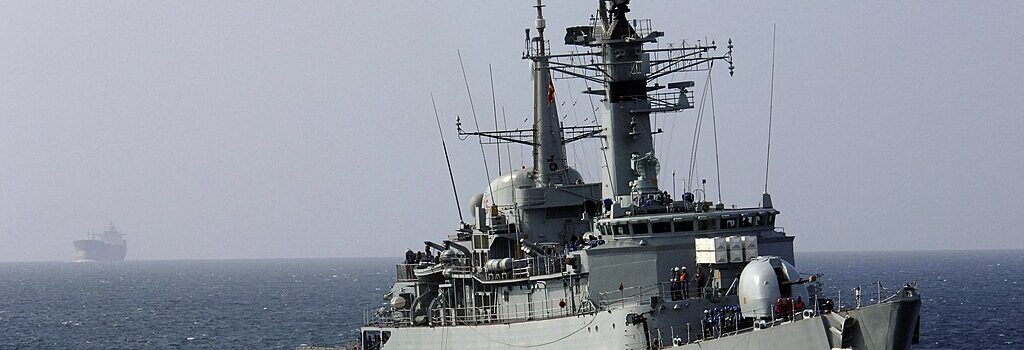
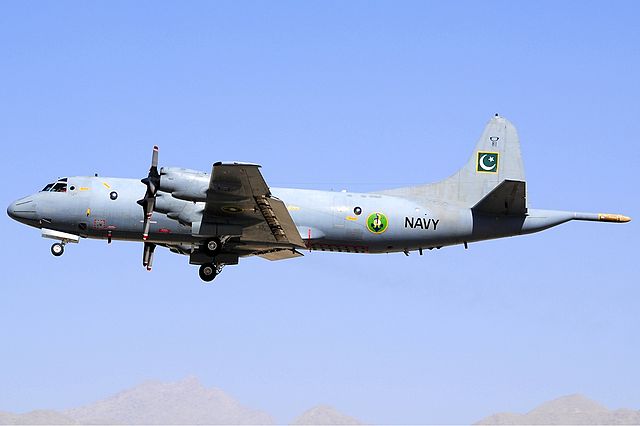
 Latest Facebook Entry -
Latest Facebook Entry -  X(Tweeter) Naval Encyclopedia's deck archive
X(Tweeter) Naval Encyclopedia's deck archive Instagram (@navalencyc)
Instagram (@navalencyc)





 French Navy
French Navy Royal Navy
Royal Navy Russian Navy
Russian Navy Armada Espanola
Armada Espanola Austrian Navy
Austrian Navy K.u.K. Kriegsmarine
K.u.K. Kriegsmarine Dansk Marine
Dansk Marine Nautiko Hellenon
Nautiko Hellenon Koninklije Marine 1870
Koninklije Marine 1870 Marinha do Brasil
Marinha do Brasil Osmanlı Donanması
Osmanlı Donanması Marina Do Peru
Marina Do Peru Marinha do Portugal
Marinha do Portugal Regia Marina 1870
Regia Marina 1870 Nihhon Kaigun 1870
Nihhon Kaigun 1870 Preußische Marine 1870
Preußische Marine 1870 Russkiy Flot 1870
Russkiy Flot 1870 Svenska marinen
Svenska marinen Søværnet
Søværnet Union Navy
Union Navy Confederate Navy
Confederate Navy Armada de Argentina
Armada de Argentina Imperial Chinese Navy
Imperial Chinese Navy Marinha do Portugal
Marinha do Portugal Mexico
Mexico Kaiserliche Marine
Kaiserliche Marine 1898 US Navy
1898 US Navy Sovietskiy Flot
Sovietskiy Flot Royal Canadian Navy
Royal Canadian Navy Royal Australian Navy
Royal Australian Navy RNZN Fleet
RNZN Fleet Chinese Navy 1937
Chinese Navy 1937 Kriegsmarine
Kriegsmarine Chilean Navy
Chilean Navy Danish Navy
Danish Navy Finnish Navy
Finnish Navy Hellenic Navy
Hellenic Navy Polish Navy
Polish Navy Romanian Navy
Romanian Navy Turkish Navy
Turkish Navy Royal Yugoslav Navy
Royal Yugoslav Navy Royal Thai Navy
Royal Thai Navy Minor Navies
Minor Navies Albania
Albania Austria
Austria Belgium
Belgium Columbia
Columbia Costa Rica
Costa Rica Cuba
Cuba Czechoslovakia
Czechoslovakia Dominican Republic
Dominican Republic Haiti
Haiti Hungary
Hungary Honduras
Honduras Estonia
Estonia Iceland
Iceland Eire
Eire Equador
Equador Iran
Iran Iraq
Iraq Latvia
Latvia Liberia
Liberia Lithuania
Lithuania Mandchukuo
Mandchukuo Morocco
Morocco Nicaragua
Nicaragua Persia
Persia San Salvador
San Salvador Sarawak
Sarawak Uruguay
Uruguay Venezuela
Venezuela Zanzibar
Zanzibar Warsaw Pact Navies
Warsaw Pact Navies Bulgaria
Bulgaria Hungary
Hungary

 Bundesmarine
Bundesmarine Dutch Navy
Dutch Navy Hellenic Navy
Hellenic Navy Marina Militare
Marina Militare Yugoslav Navy
Yugoslav Navy Chinese Navy
Chinese Navy Indian Navy
Indian Navy Indonesian Navy
Indonesian Navy JMSDF
JMSDF North Korean Navy
North Korean Navy Pakistani Navy
Pakistani Navy Philippines Navy
Philippines Navy ROKN
ROKN Rep. of Singapore Navy
Rep. of Singapore Navy Taiwanese Navy
Taiwanese Navy IDF Navy
IDF Navy Saudi Navy
Saudi Navy Royal New Zealand Navy
Royal New Zealand Navy Egyptian Navy
Egyptian Navy South African Navy
South African Navy






























 Ukrainian Navy
Ukrainian Navy dbodesign
dbodesign